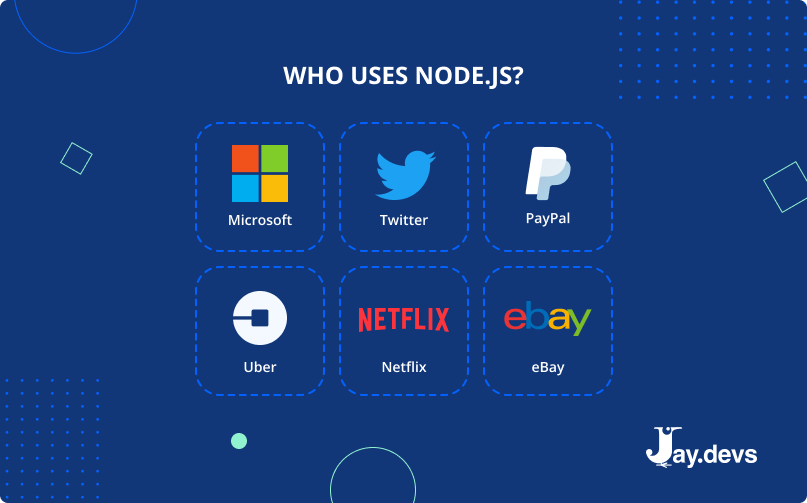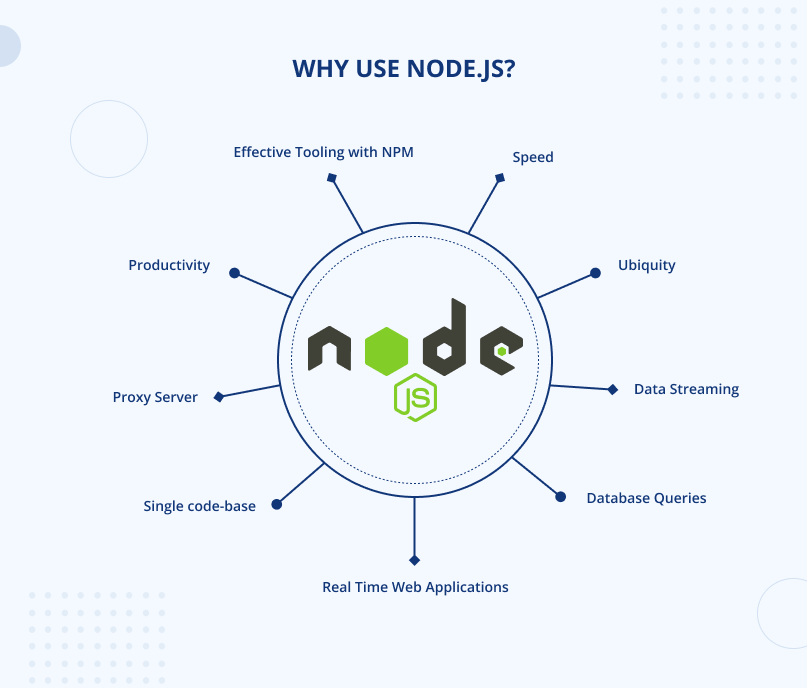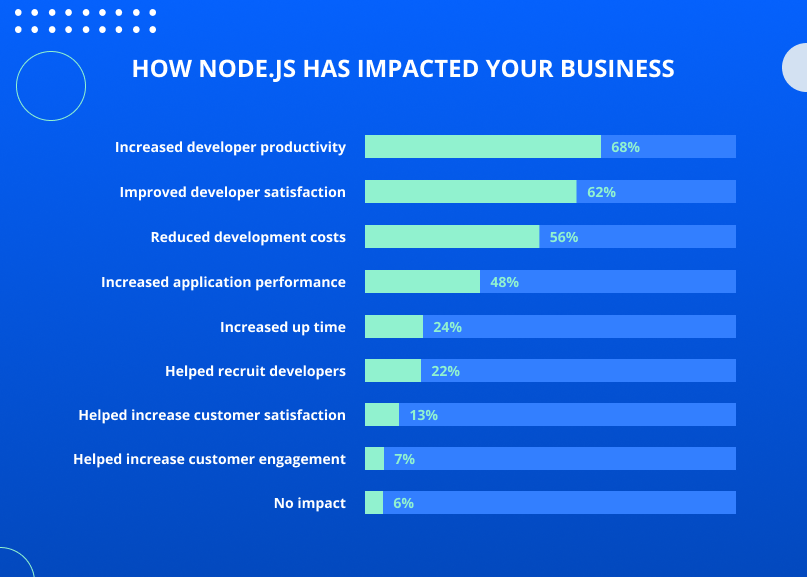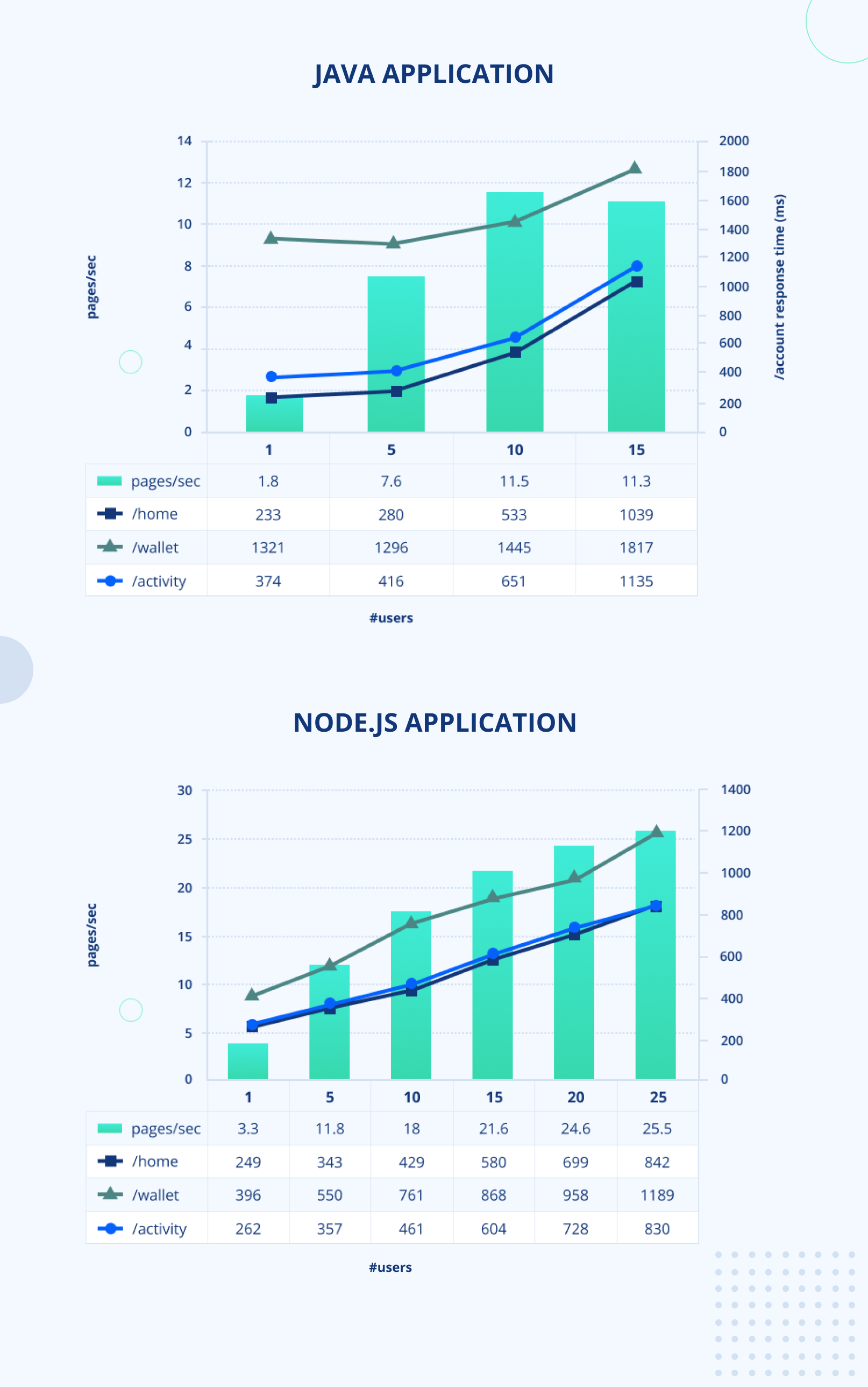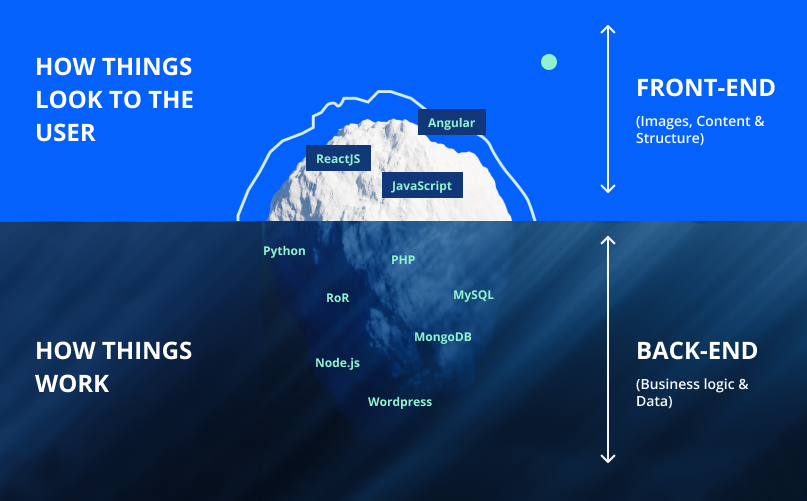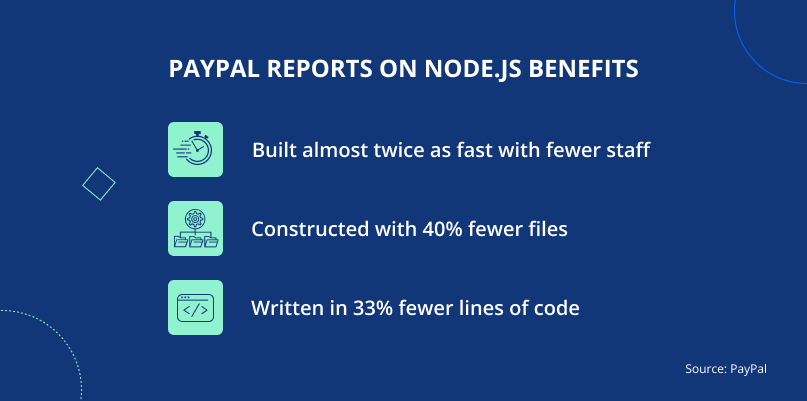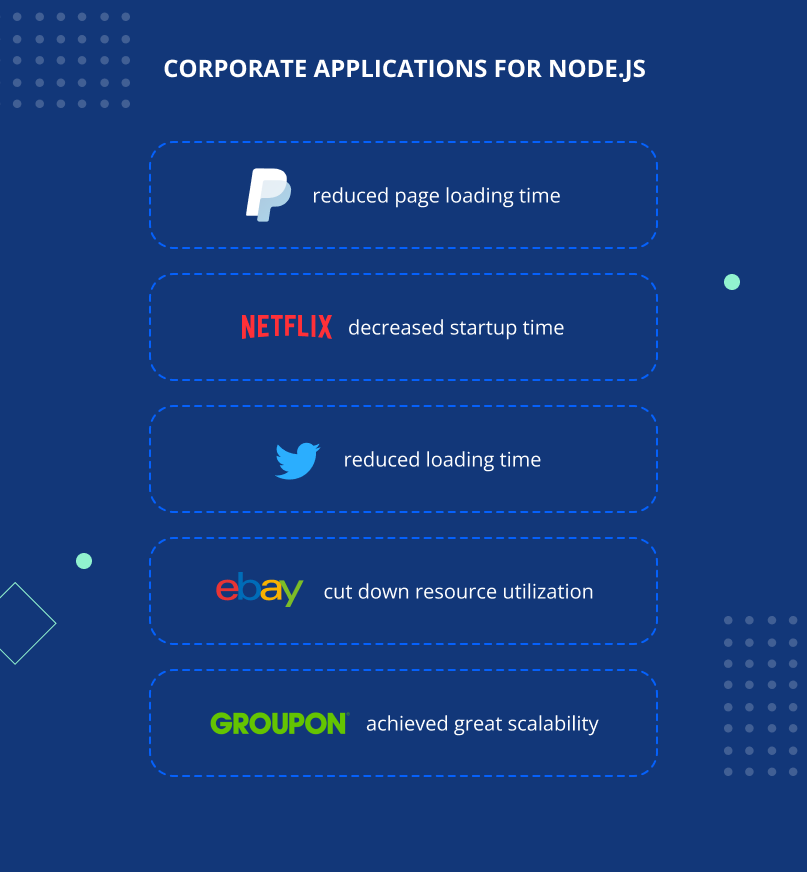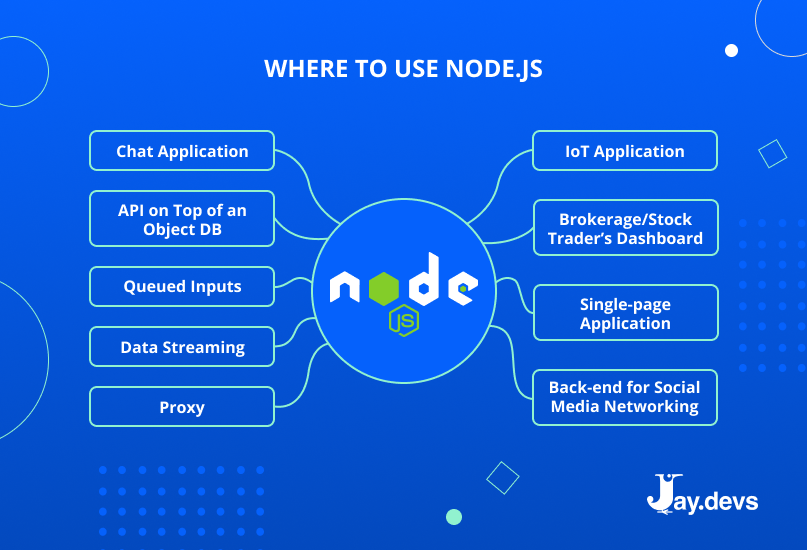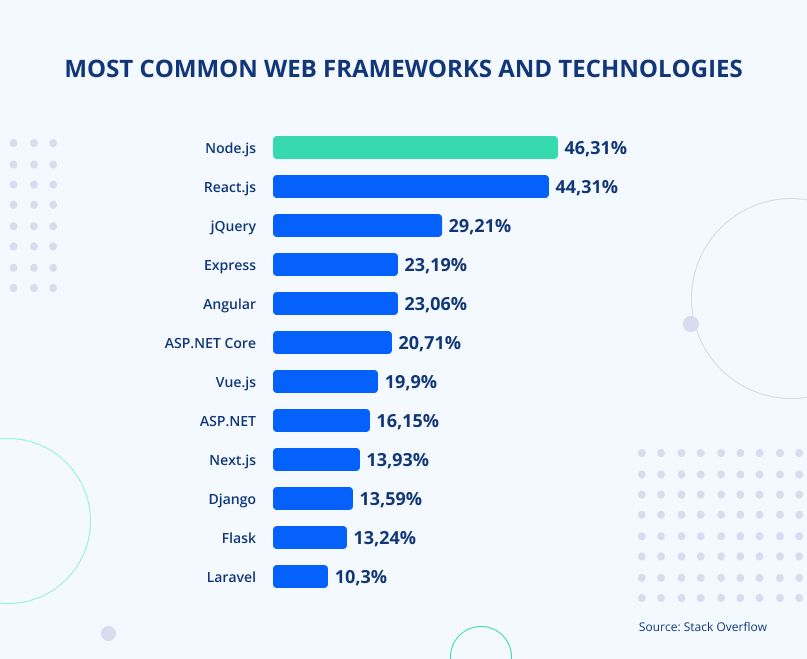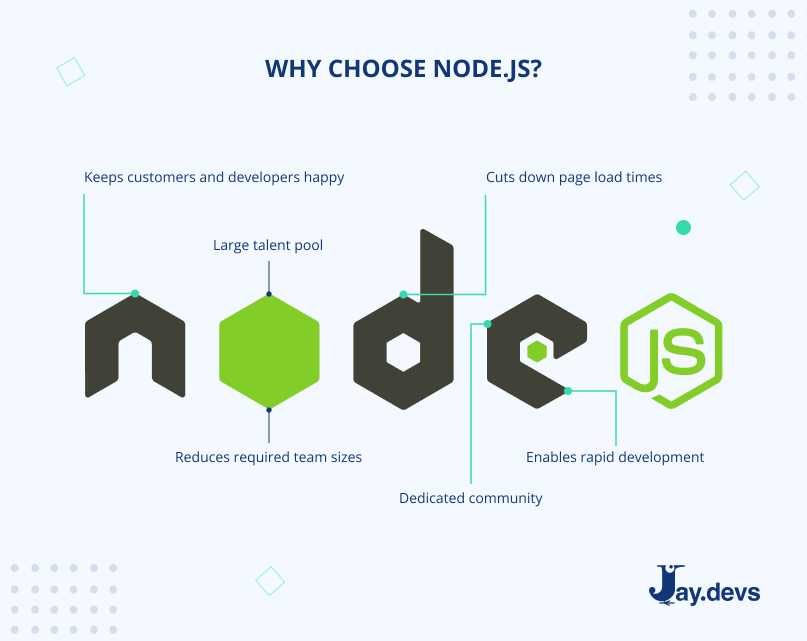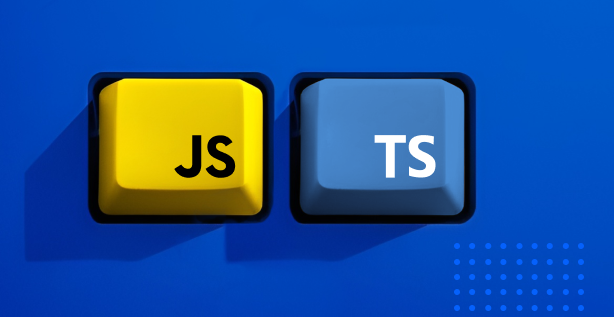Node.js is a powerful JavaScript runtime environment that allows companies to speed up development, cut staffing costs, and run apps faster and with fewer resources.
This article will look at what is Node JS, when to use NodeJS, and how developing with this JavaScript language can benefit your application project.
What Does Node.js Do?
Node.js is a free, open-source server runtime environment that uses JavaScript on the server. It’s available on numerous platforms such as Windows, Mac OS X, Linux, Unix, etc.
The use of Node JS enables developers to efficiently build back-end, front-end, and full-stack applications with the JavaScript language.
Node.js was created by Ryan Dahl in 2009 and is currently developed by the OpenJS Foundation. It was designed specifically to build scalable network applications.
Node.js uses an asynchronous event-driven runtime, which optimizes scalability and throughput in web applications.
The asynchronous event-driven runtime of Node.js is powered by its event loop mechanism. The event loop is responsible for handling all the I/O operations and events in a non-blocking way, which allows Node.js to efficiently handle multiple requests and perform well even under high traffic loads.
The event loop continually checks for new events, processes them in a loop, and then executes the associated callbacks when the relevant event is detected. This approach allows Node.js to efficiently handle I/O-bound tasks without getting blocked, making it a popular choice for building high-performance web applications.
Why Use NodeJS?
Many companies are interested in why Node JS is used, and one reason is its ability to efficiently handle incoming requests for server files by eliminating waiting.
Another reason is that Node is highly scalable. This is because almost no function in Node.js directly performs I/O, so the design is free from locks, thereby preventing deadlocks.
Node JS usage is also memory efficient due to its single thread, non-blocking asynchronous design.
The Node.js user survey reported that developers who use it enjoyed benefits such as increasing developer productivity, reducing software development costs, increasing application performance, and increasing customer satisfaction and engagement.
Let’s break down some key points in more detail below to illustrate why NodeJS use is so popular.
Node.js Wins with Speed
A big reason to use Node JS is because it has a high execution speed for processing requests.
Its I/O operations don’t block one another, so you can read files, send emails, and query a database simultaneously.
Node.js Wins with Ubiquity
Using Node JS makes JavaScript more versatile, as it can run on the client’s browser and server.
JavaScript is known as a front-end programming language, but Node.js expands its capabilities to the back-end.
If you’re still wondering why you use Node.js, look at what it did for PayPal. PayPal reported that the use of Node.js reduced the average response time for the same page by 35%, resulting in pages being served 200ms faster.
Node.js Wins with Data Streaming
One of the many uses of Node JS is the implementation of fast and efficient data streaming applications.
On older systems, HTTP requests and responses are separate events as opposed to data streams. Node.js can be used to process files while uploading, reducing the overall time required.
Node.js Wins with Database Queries
Node.js also extends to database queries. One of the reasons why Node.js is particularly well-suited for this task is because modern NoSQL databases are commonly coded in JavaScript. As a result, Node.js can seamlessly integrate with NoSQL databases, making it easier for developers to work with databases and speeding up the development process.
What does Node JS do that makes it so popular for databases apart from its base language? Its JSON data format also enables it to operate rapidly without the data conversion process required for frameworks like Ruby on Rails.
Real-Time Web Applications Are a Walk in the Park with Node.js
Real-time applications that handle many users at once are among the possibilities of what you can do with Node.js.
Node JS is used for such applications as its event-driven, asynchronous design enables it to efficiently manage a large volume of requests.
A Single Code-base for Real-time Web Applications
Node.js can be used to create both the back-end and front-end of an application using a single codebase. This approach enables the use of JavaScript on both the client-side and server-side, making data synchronization between the server and client seamless.
Secret to Increased Productivity
Where Node JS is used includes when a company wishes to gain the efficiencies associated with using a single code-base (JavaScript) for both front-end and back-end development.
Companies may need to create separate teams for front-end and back-end development if they do not hire Node.js developers.
So NodeJS use cases include combining front-end and back-end teams, all working with a single programming language and being on the same page concerning the technology being implemented.
Just ask PayPal. Rather than using two programming languages, PayPal reported that teams “could move faster with JavaScript” and Node.js. As a result of switching over to Node.js, the team was able to build apps almost twice as fast, with fewer developers!
Node.js Comes to the Rescue as Proxy Server
Node.js can serve as a proxy server between services with varying response times or as a means to gather data from multiple sources. One common use case for Node.js is when a back-end application needs to communicate with or collect data from various sources but lacks the infrastructure to create a proxy. In such cases, Node.js can act as the proxy, providing an efficient and reliable solution.
Effective Tooling with NPM
The Node package manager (NPM) is the default package manager for Node.js, which has 1.3 million packages available in the main registry.
How to use Node.js package manager? NPN is a robust dependencies management tool that allows developers to auto-update required packages while also preventing unwanted changes.
Service Providers Hosting NodeJS Deployments
For those who are unsure about how to use NodeJS, a potential solution is to utilize the platform as a service (PaaS) provider, such as Heroku, that offers support for Node.js deployments with just a single command. As the number of hosting services that support Node.js continues to rise, this has become a feasible and practical option.
What is Node JS used for? Examples of Popular Companies Using Node.js
Node is used as a preferred JavaScript runtime environment at a range of top-tier tech companies.
Some examples include Uber, Netflix, Microsoft, Twitter, PayPal, Reddit, NASA, eBay, Groupon, and The New York Times.
To get a bit more specific about what is Node.js used for at these companies, let’s look at some examples.
Netflix reduces startup time using Node.js, while NASA cuts down database access time with it. PayPal decreased page loading time, as did Twitter. eBay cut down on resource utilization, while Groupon achieved greater scalability.
Where to Use Node.js?
We’ll cover some common use cases for Node.js below.
Chat Application
Node.js excels in developing chat apps because of its design. Node.js can handle messages as they come in and prevent a backlog from building up.
API on Top of an Object DB
Node.js is a good solution for the above application as it operates without the need for data conversion and can use a uniform data format across the back-end and front-end.
Queued Inputs
The ability of Node.js to handle many concurrent connections and push database write-offs for later processing makes it a good choice for handling queued inputs.
Data Streaming
Node.js is well-suited to data streaming applications as it has built-in modules for creating writable and readable data streams, which is taken advantage of by streaming apps such as Netflix.
Proxy
As a proxy, Node.js is a flexible solution that acts as an intermediary between services with different response times or assists data collection from different sources.
Brokerage/Stock Trader’s Dashboard
With its strength in handling real-time apps, Node.js is well-suited to brokerage/stock trading dashboards due to its speed of operation and efficiency.
IoT Application
Node.js is a preferred solution for the Internet of Things (IoT) because it can process numerous concurrent requests from many networked devices while maintaining speed and performance.
Single-page Application
Single-page applications are a common method of web design that aims to provide the entire app on a single page. Node.js is right at home for this use application as it can deal with the asynchronous calls and data-intensive workloads required to provide a smooth user experience.
The back-end for Social Media Networking
Social networks are often single-page applications, so from that angle, Node.js is a good fit. It’s also a popular choice for the back-end due to its speed of operation and ability to be used as a single code-base solution when the front-end is also based in JavaScript.
Where to Use Node.js, but Cautiously
It’s good to know when to use Node.js, but it’s important to understand how to use Node JS effectively, and that it may not always be the best solution. We’ll discuss such cases below.
Server-side Web Applications with a Relational Database on Back-end
We’ve discussed what Node is used for, but historically Node.js featured limited relational database tools compared to other platforms.
Nonetheless, numerous developers still use and support Node.js for this application, using, for example, MySQL and Sequelize.
When Is Node.js Not a Good Idea?
We’ve outlined what you can do with Node JS, but it’s not a good fit for all projects. We’ll outline such cases below.
CPU-heavy Server-side Computation
Node.js performs efficiently for numerous applications. However, by default, it runs on a single CPU core due to its single-threaded design, even if there are more available on your machine or virtual machine.
Fortunately, there are now Node.js modules available that allow you to create parallel tasks and work on multiple threads simultaneously.
Just keep in mind that if you want to use this functionality, it will require a more complex setup.
CRUD Apps
If you’re wondering “What can I do with Node JS?”, if you want to build a simple CRUD app, with data incoming directly from the server without a requirement for an API, it’s possible to do so using Node.js.
However, using Node.js for this may be overkill as its high-powered features will not be required for such a project.
Other Considerations to Remember When Choosing Node.js
We’ve addressed what you can do with Node.js, and now we’ll add a final practical consideration related to which solution to select for your project.
This is whether skilled developers are available to complete the work required with your chosen technology stack.
In this regard, you have nothing to worry about with Node.js. The 2022 Stack Overflow Developer Survey found that Node.js is the most common web technology, with 46.31% of professional developers using it.
Node.js use has grown in the past 12 months, so trends suggest companies will have access to a large pool of Node.js developers moving forward.
Why Choose Node.js? Conclusion
We’ve outlined what you can do with NodeJS in several contexts and now we’ll wrap up the big-picture benefits of using Node.js for your project.
Node.js is a popular runtime environment for executing server-side JavaScript code. It is often used for building scalable, high-performance web applications, particularly those with real-time features like chat applications, online gaming platforms, or collaborative tools.
Using Node.js helps ensure customer and developer satisfaction and reduces team size and hiring costs.
It cuts down page loading times and reduces the server requirements for hosting.
Furthermore, Node.js boasts a large, dedicated community, and a large talent pool is available for hire.
However, Node.js may not be the best choice for CPU-intensive tasks or applications that require extensive processing of large amounts of data, as its performance may be limited in these areas.





